总结
这个月马上就又要过去了,还在找工作的小伙伴要做好准备了,小编整理了大厂java程序员面试涉及到的绝大部分面试题及答案,希望能帮助到大家


-
- 1.软件环境
-
2.功能模块图
-
3.系统功能
-
4.数据库表
-
5.工程截图
-
二、系统展示
-
- 1.系统登录
-
2.系统主页
-
3.新增用户
-
4.查询用户
-
5.更新用户
-
6.新增客户
-
7.查询客户
-
8.更新客户
-
9.新增联系人
-
10.查询联系人
-
11.更新联系人
-
12.新增线索
-
13.查询线索
-
14.更新线索
-
15.新增商机
-
16.查询商机
-
17.更新商机
-
三、代码实现
-
- BusinessController
-
ClueController
-
ContactController
-
CustomerController
-
FrontendController
-
UserController
-
business-add.js
-
business-list.js
-
business-update.js
-
business-add.html
-
business-list.html
-
business-update.html
-
四、其他
-
- 1.其他系统实现
-
-
- JavaWeb系统系列实现
-
-
JavaSwing系统系列实现
-
2.获取源码
-
3.备注
-
4.鸡汤
=====================================================================
IDEA:2018.2
Java:jdk1.8
Mysql:8.0.13
Tomcat:8.5.23
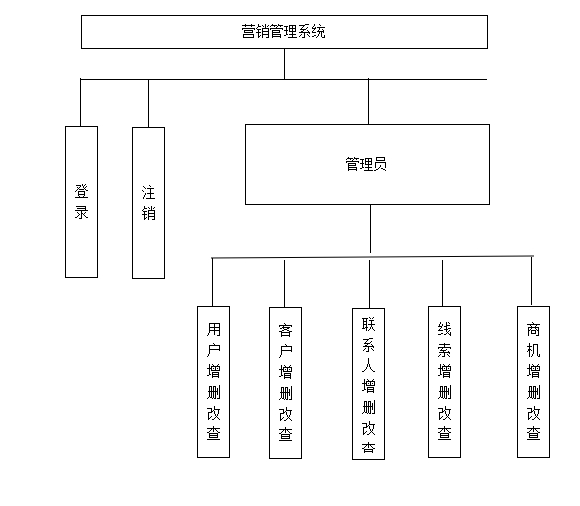
系统设计的目标是开发一个能够实现线上营销管理的系统,实现线索、商机信息记录等功能。系统主要包含五个功能模块:线索信息管理模块、客户信息管理模块、联系人信息管理模块、商机信息管理模块、员工信息管理模块。各模块具体功能如下:
1.线索信息管理模块
销售人员登录系统后,将自己找到的线索信息录入到系统中,或查看系统中已有线索,对某些线索进行信息更新。
2.客户信息管理模块
销售人员登录系统后,将已经与公司产生交易的客户信息录入到系统中,或将已经达成交易的线索转化为客户,对某些已有客户信息进行更新。
3.联系人信息管理模块
销售人员登录系统后,录入系统中已存在客户的联系人的信息,方便以后进行客户的回访和关系维护。
4.商机信息管理模块
当之前的线索成交并转化为客户后,销售人员需要将已成交信息作为商机录入到系统中,供公司日后查看和分析。
5.员工信息管理模块
管理员在系统中为公司新入职销售人员添加账号,并维护其部门信息等基本信息,同时将已离职员工账号禁用。为更换手机号员工重置登录账号,为忘记密码员工重置密码。
1.客户表
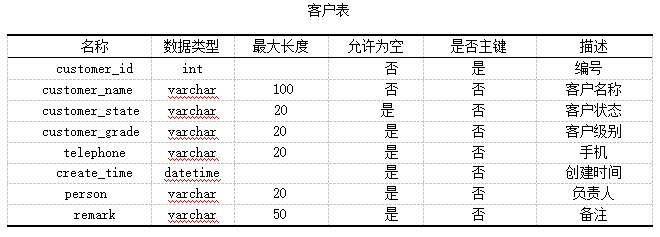
2.联系人表
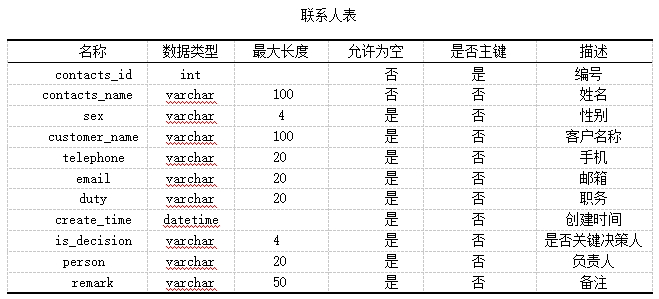
3.商机表
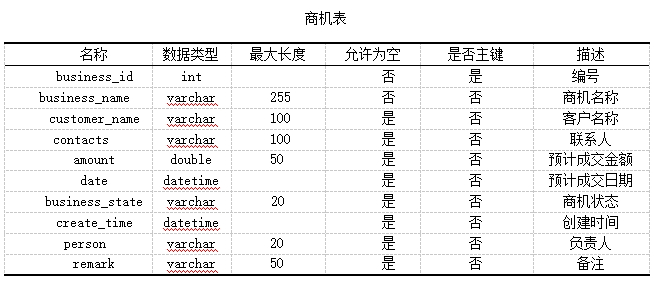
4.线索表

5.用户表
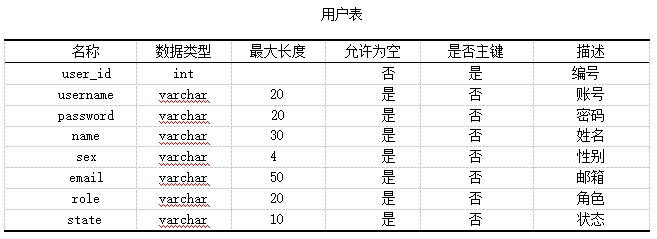
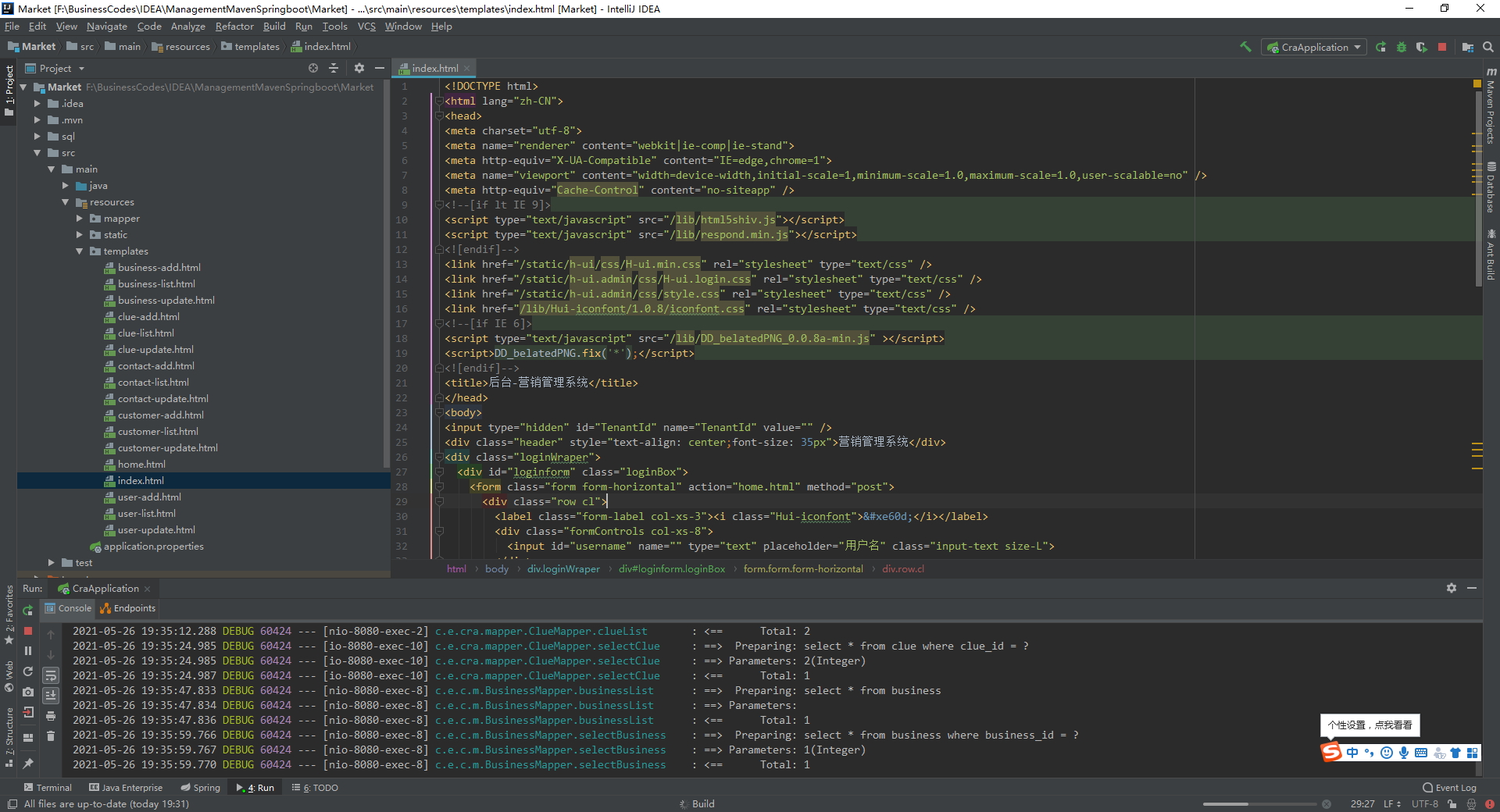
=====================================================================
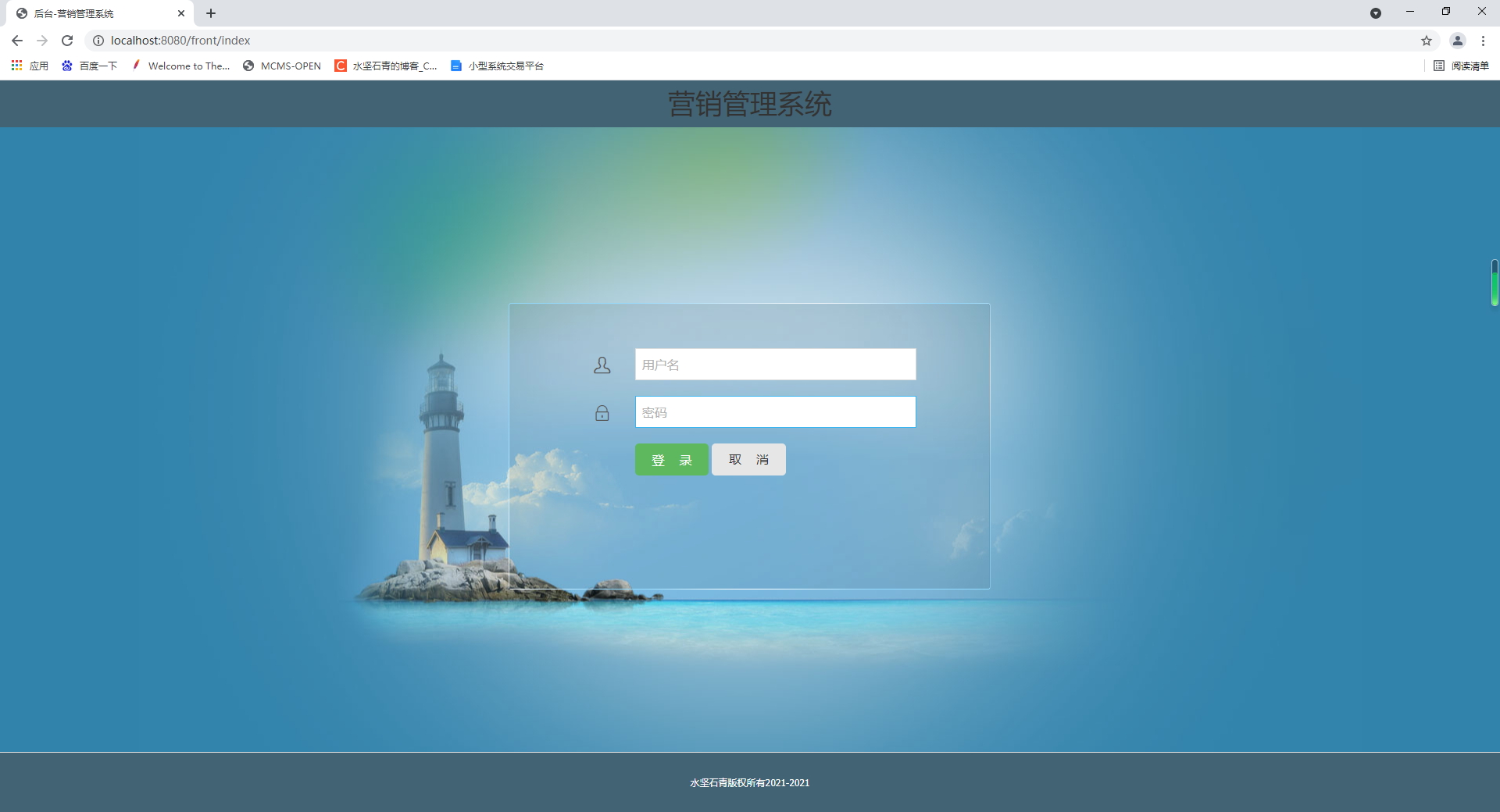
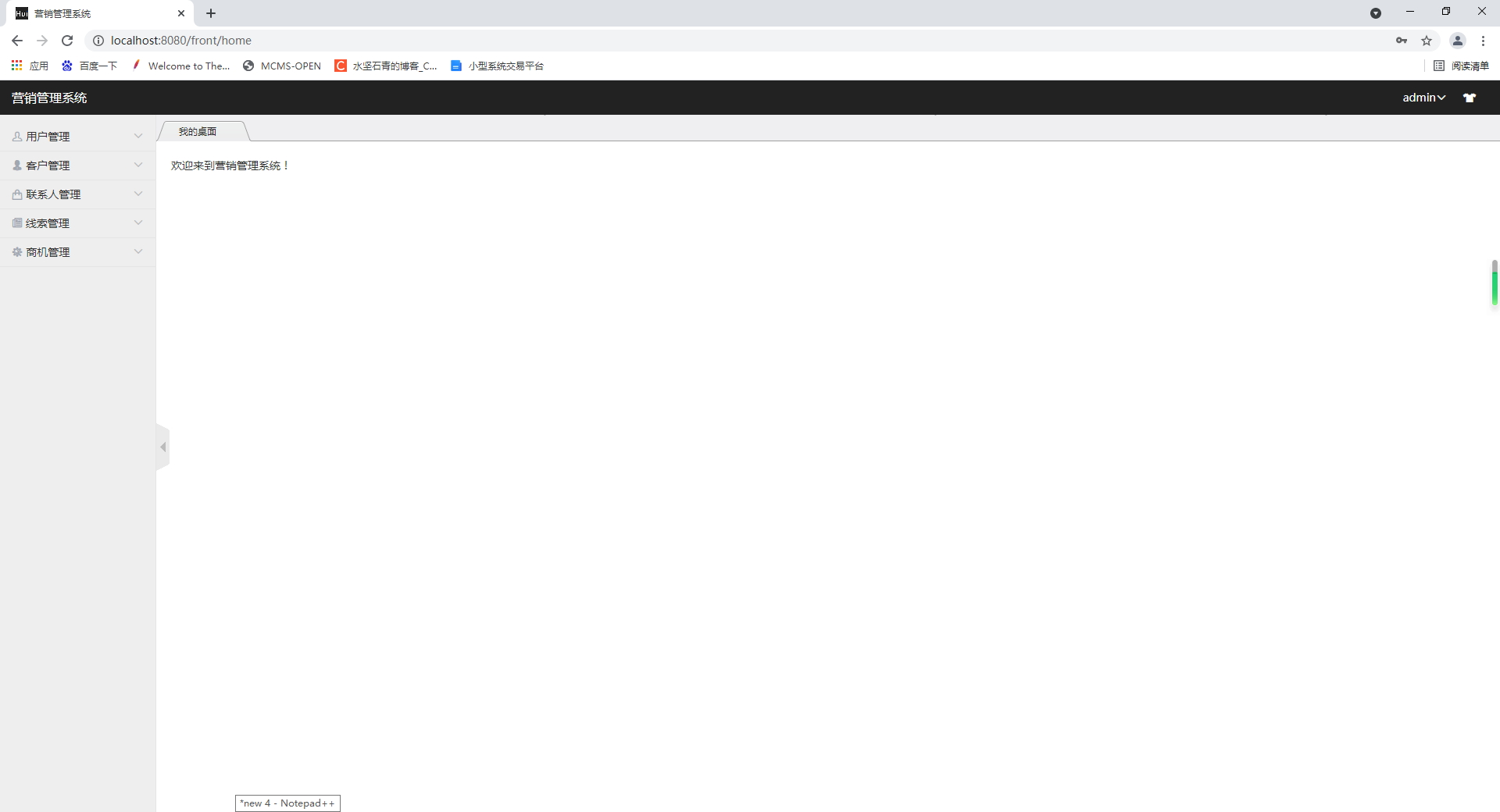
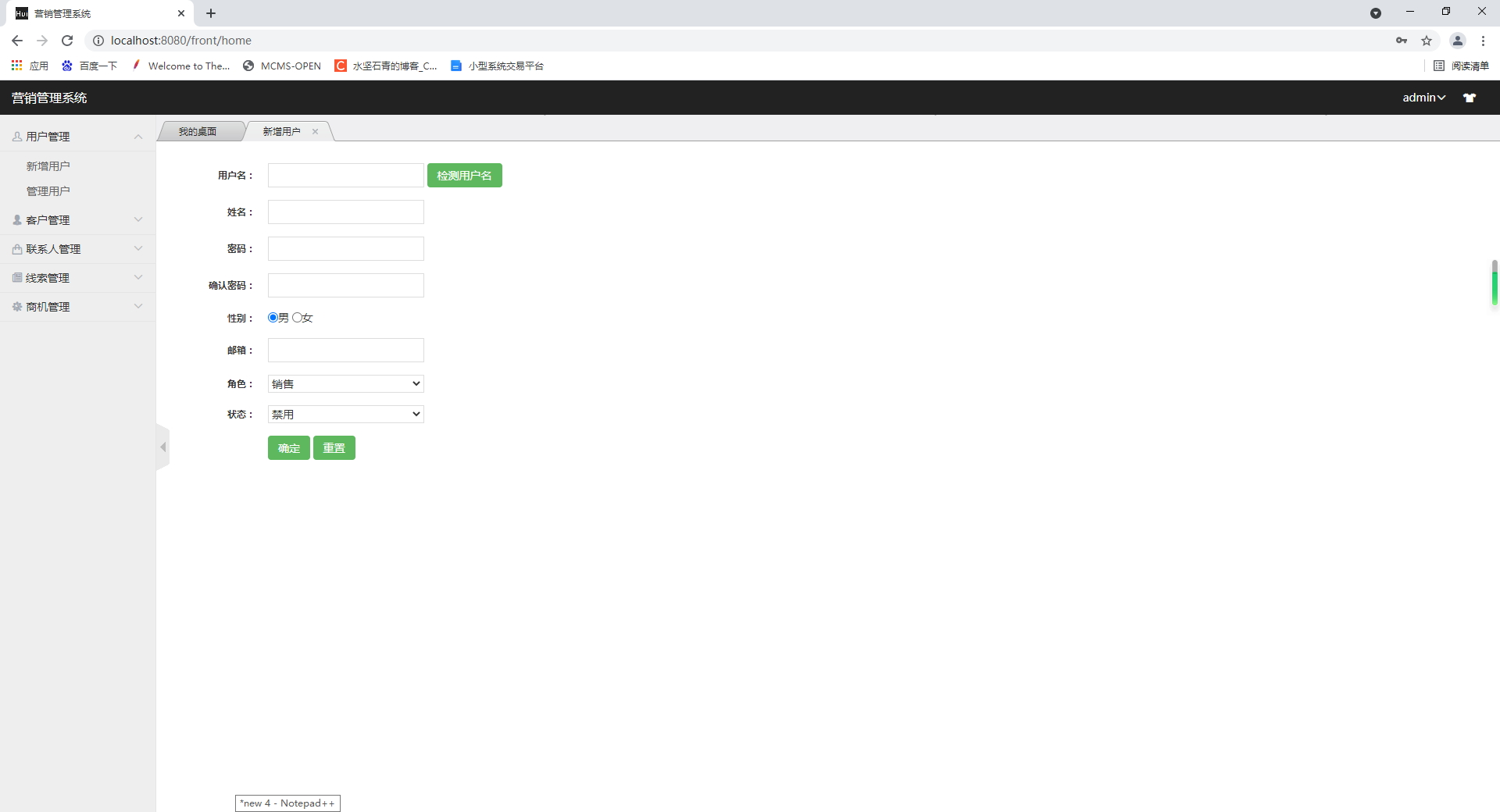

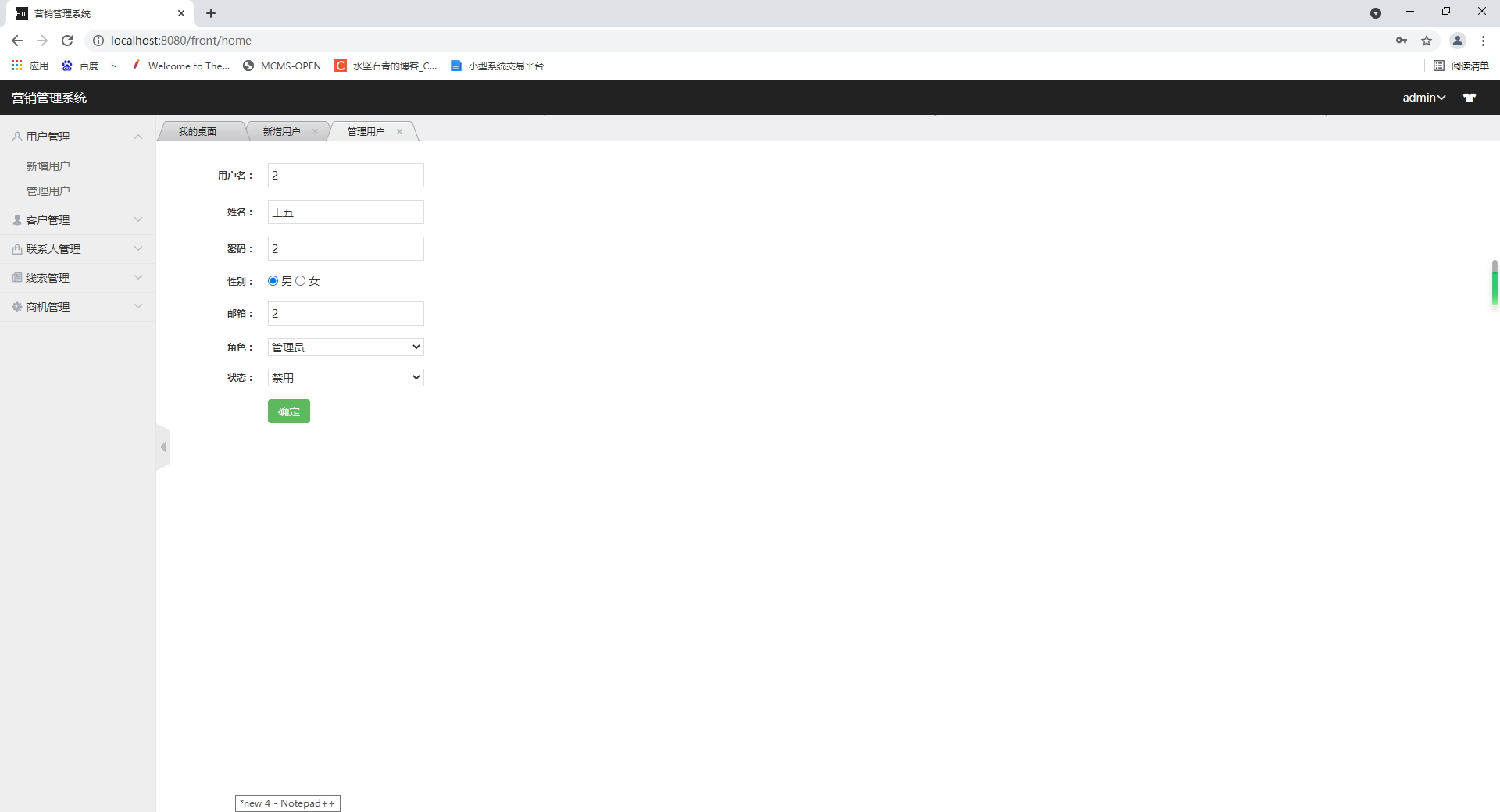
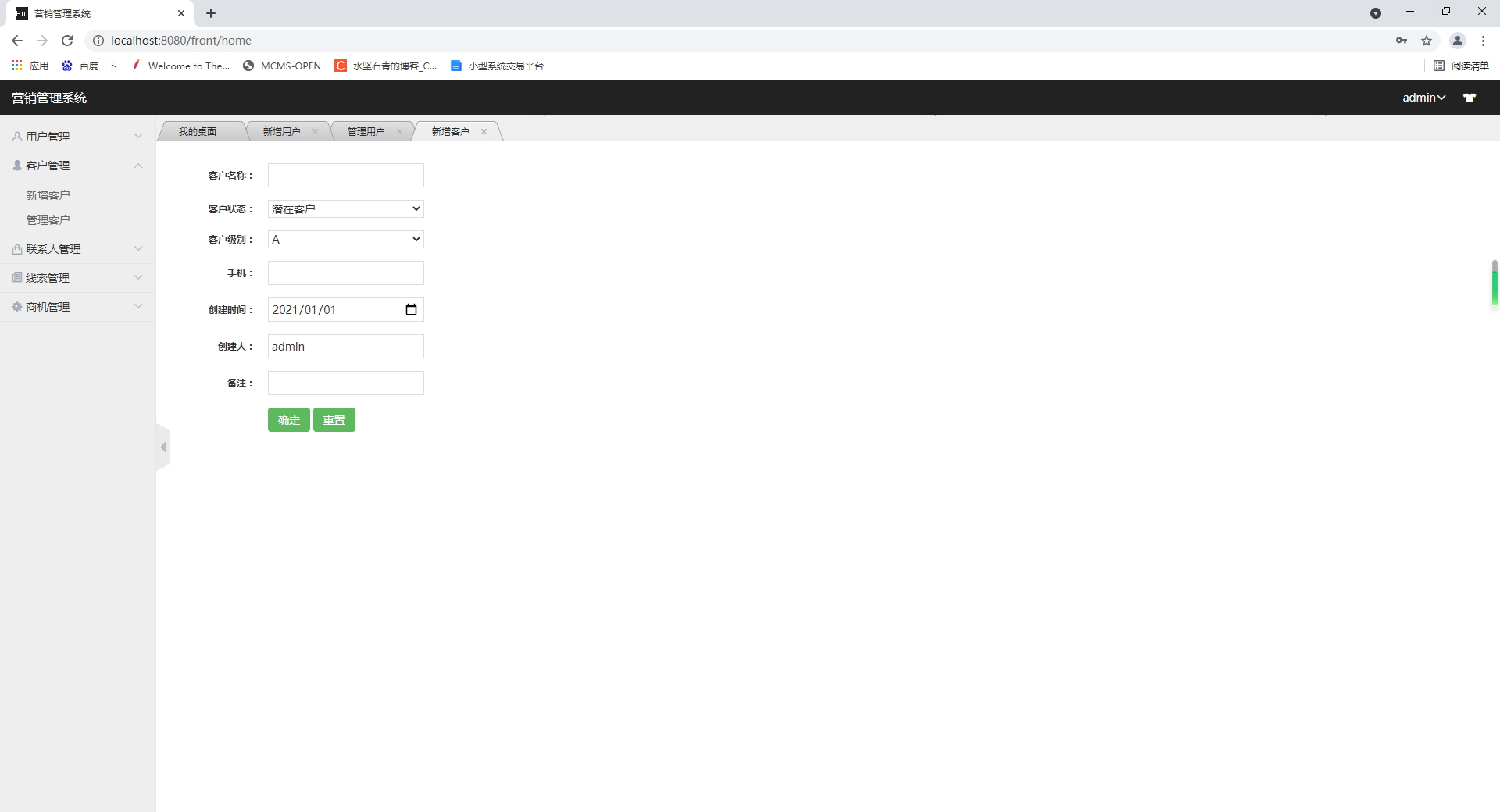
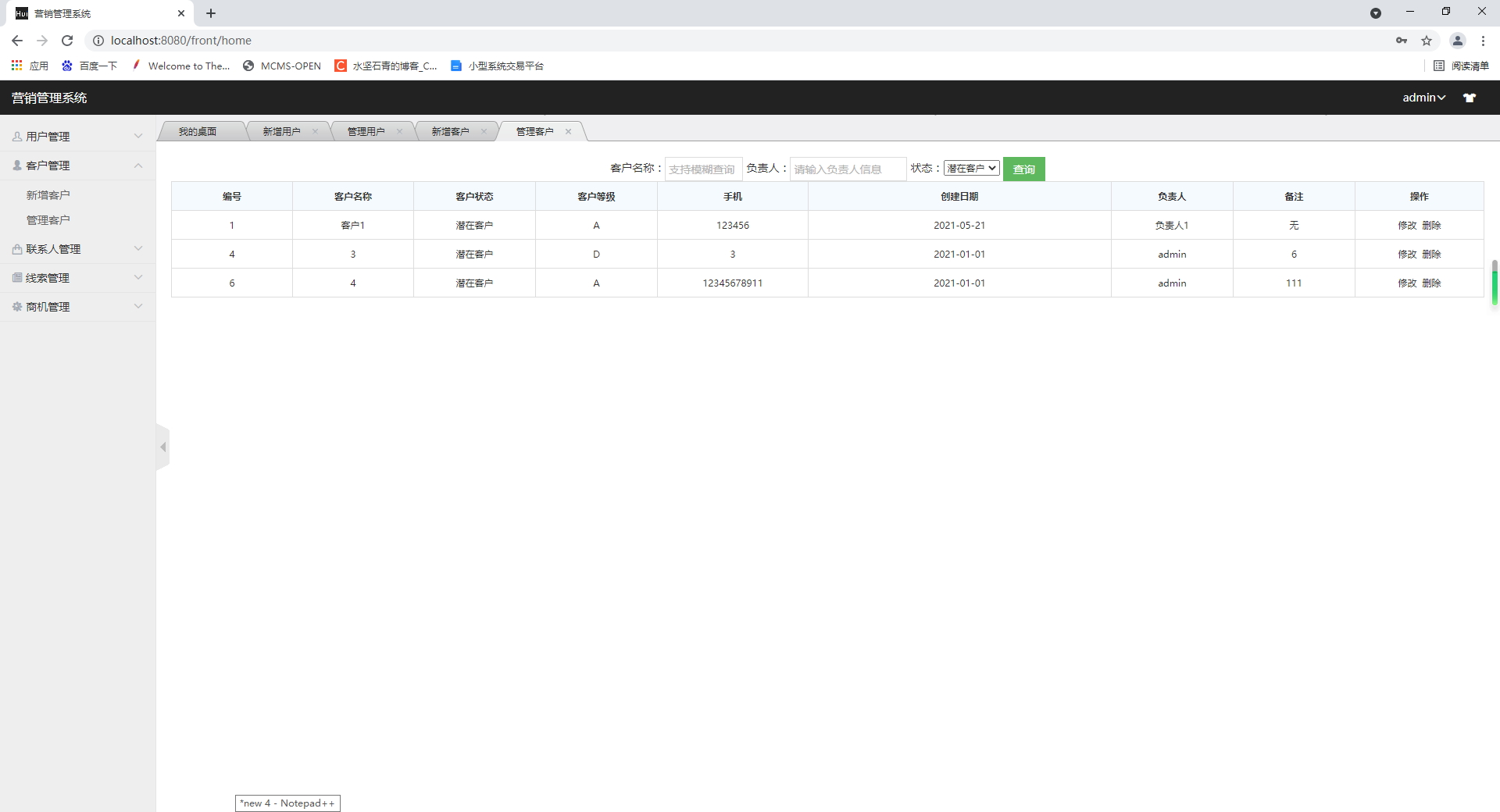

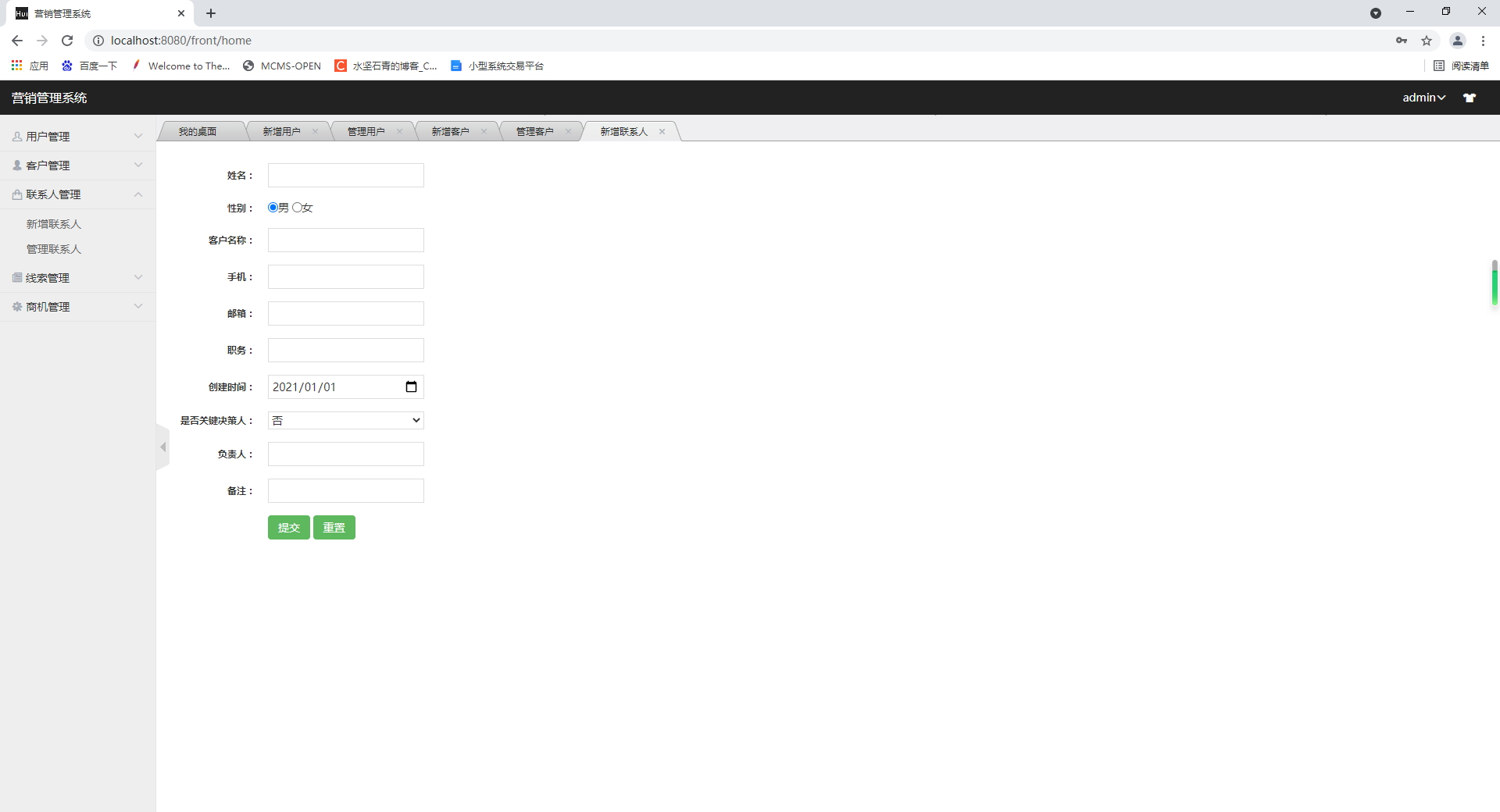
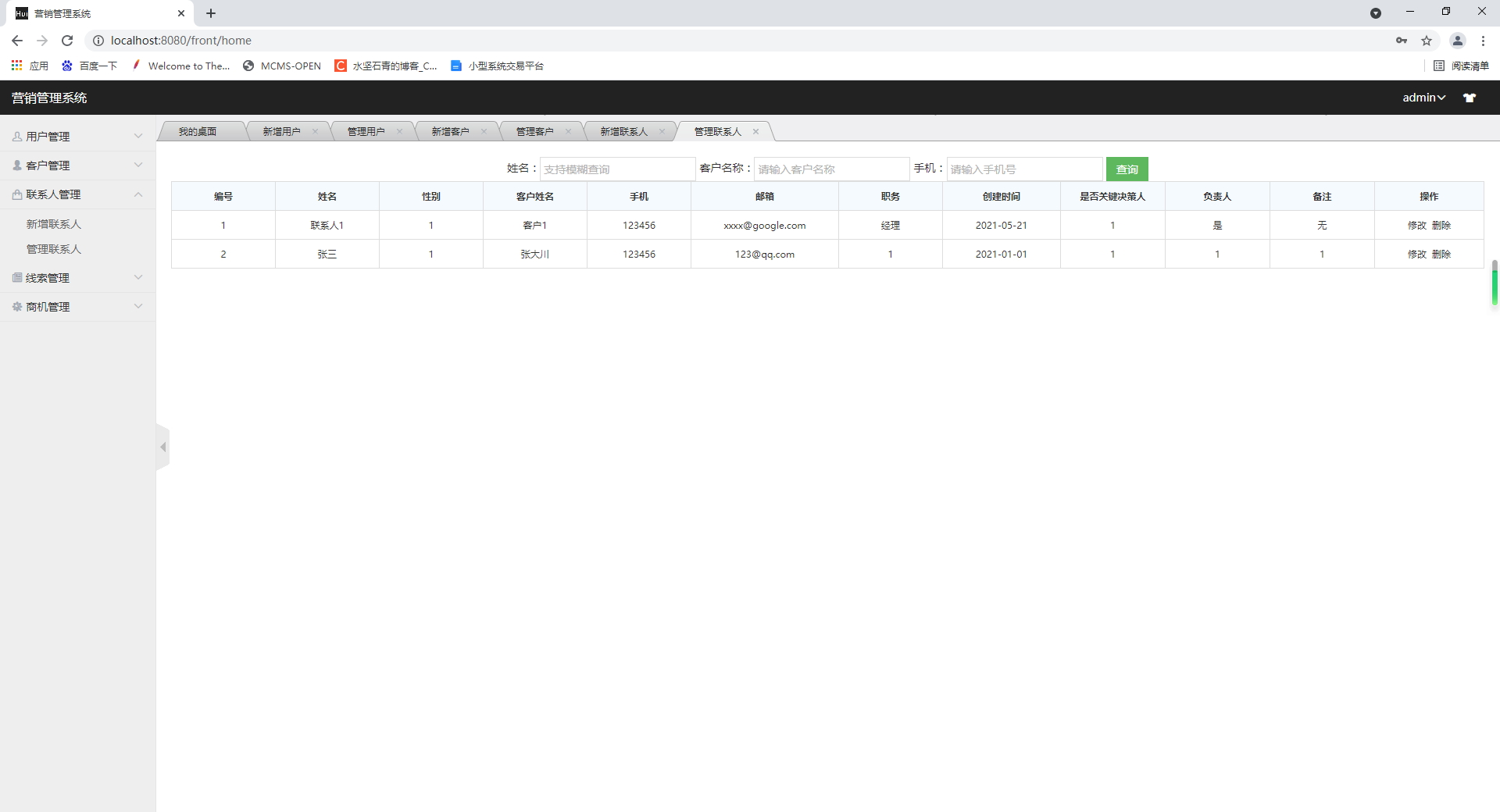
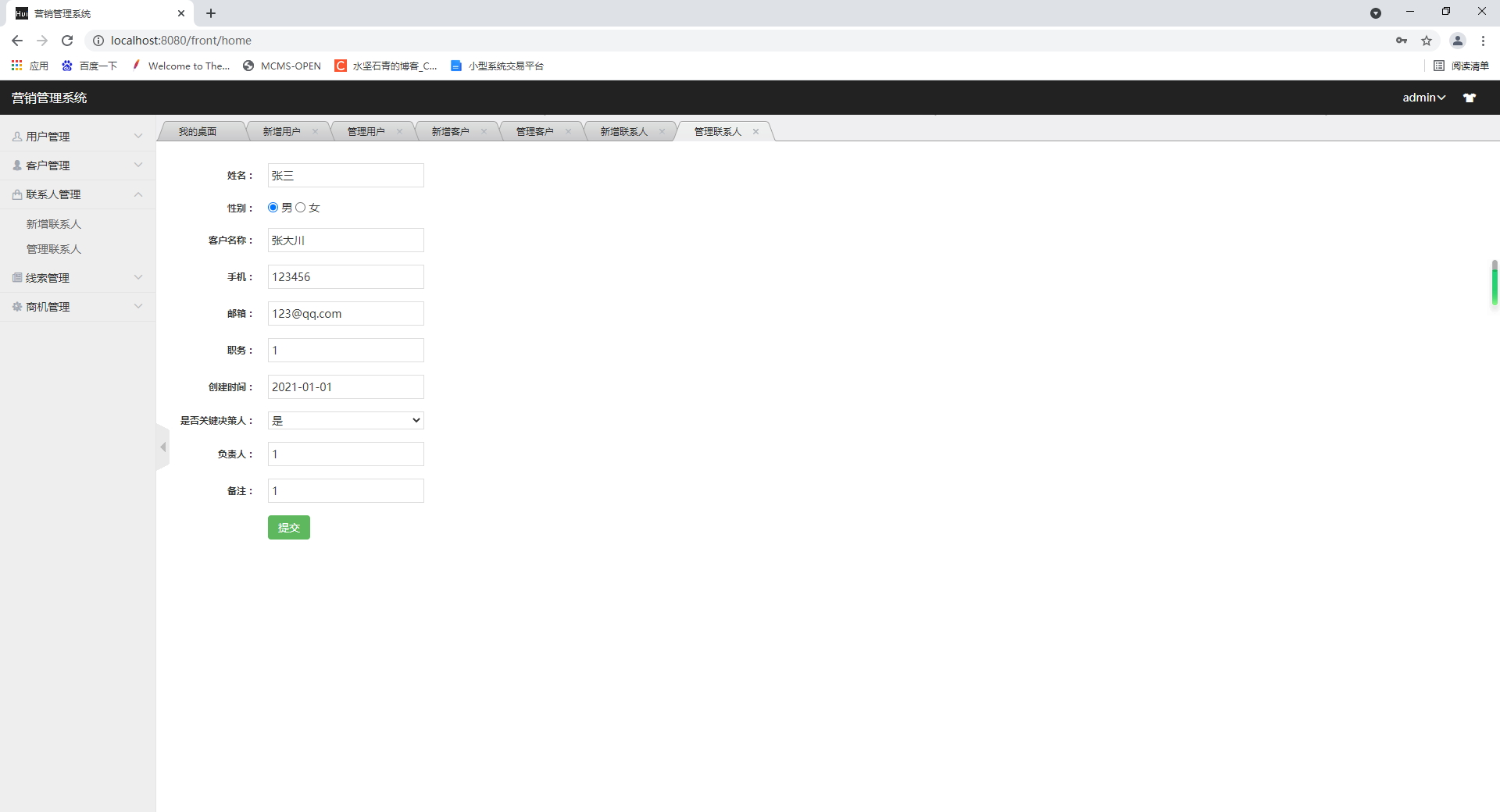
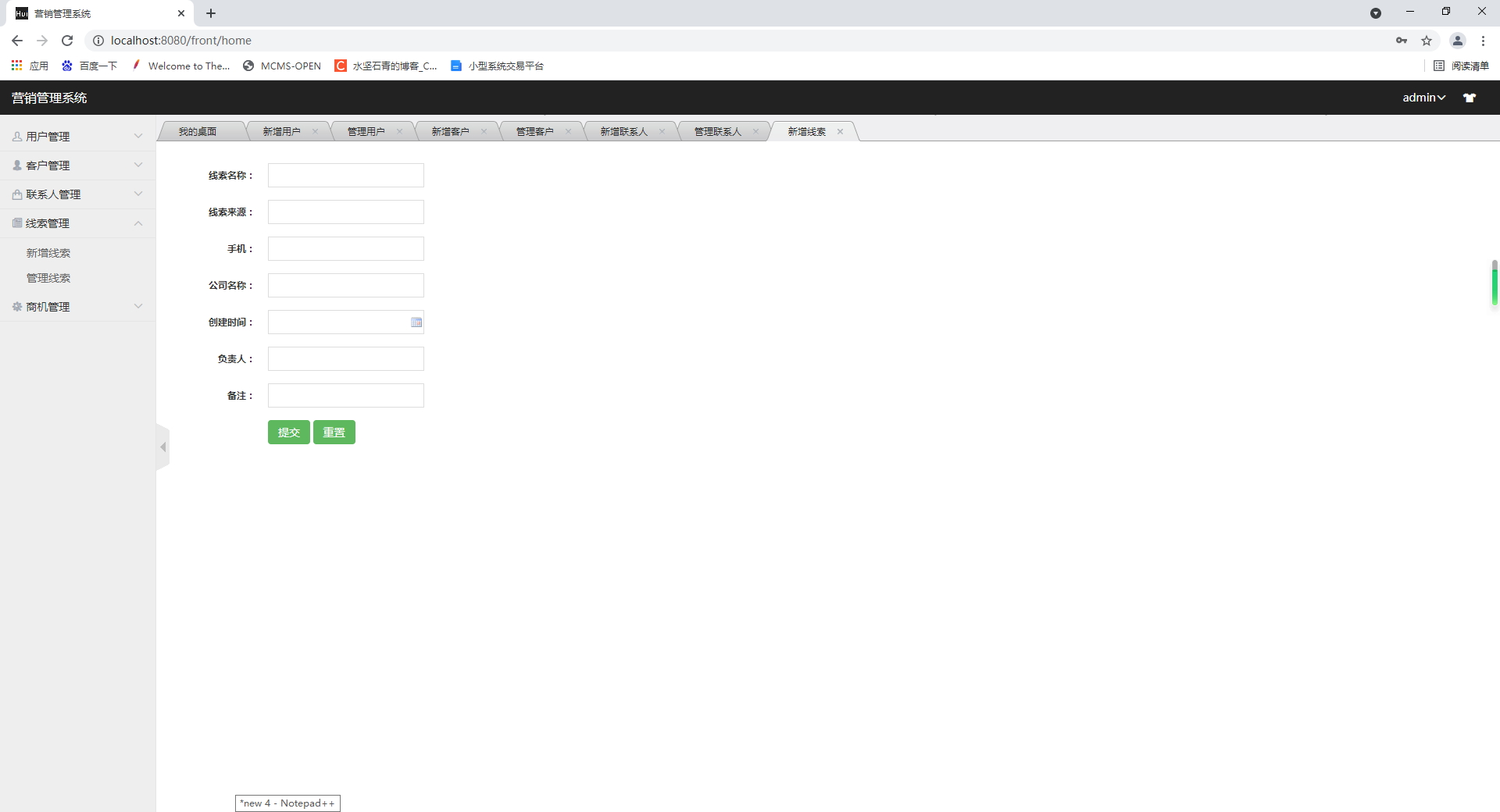
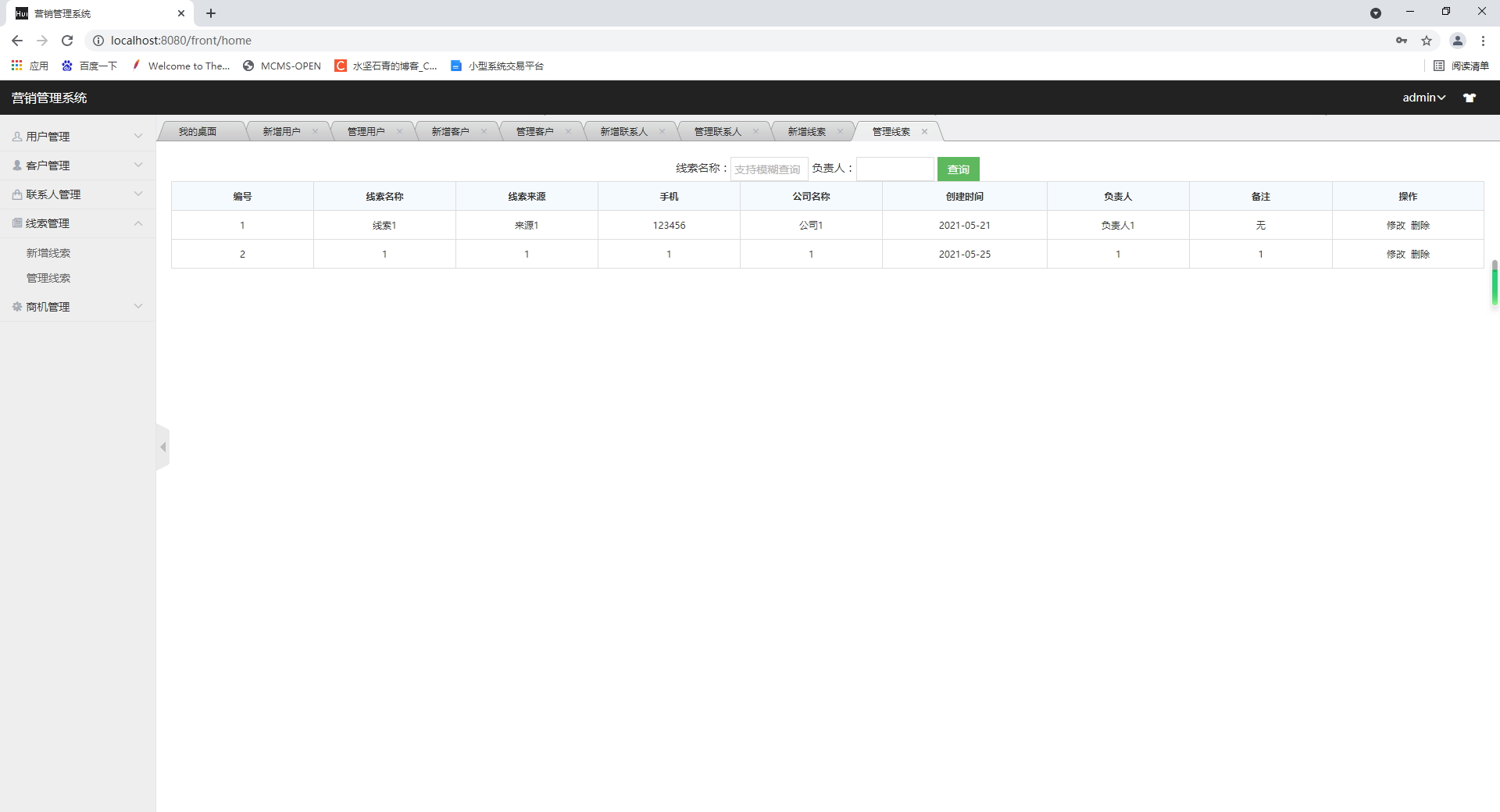
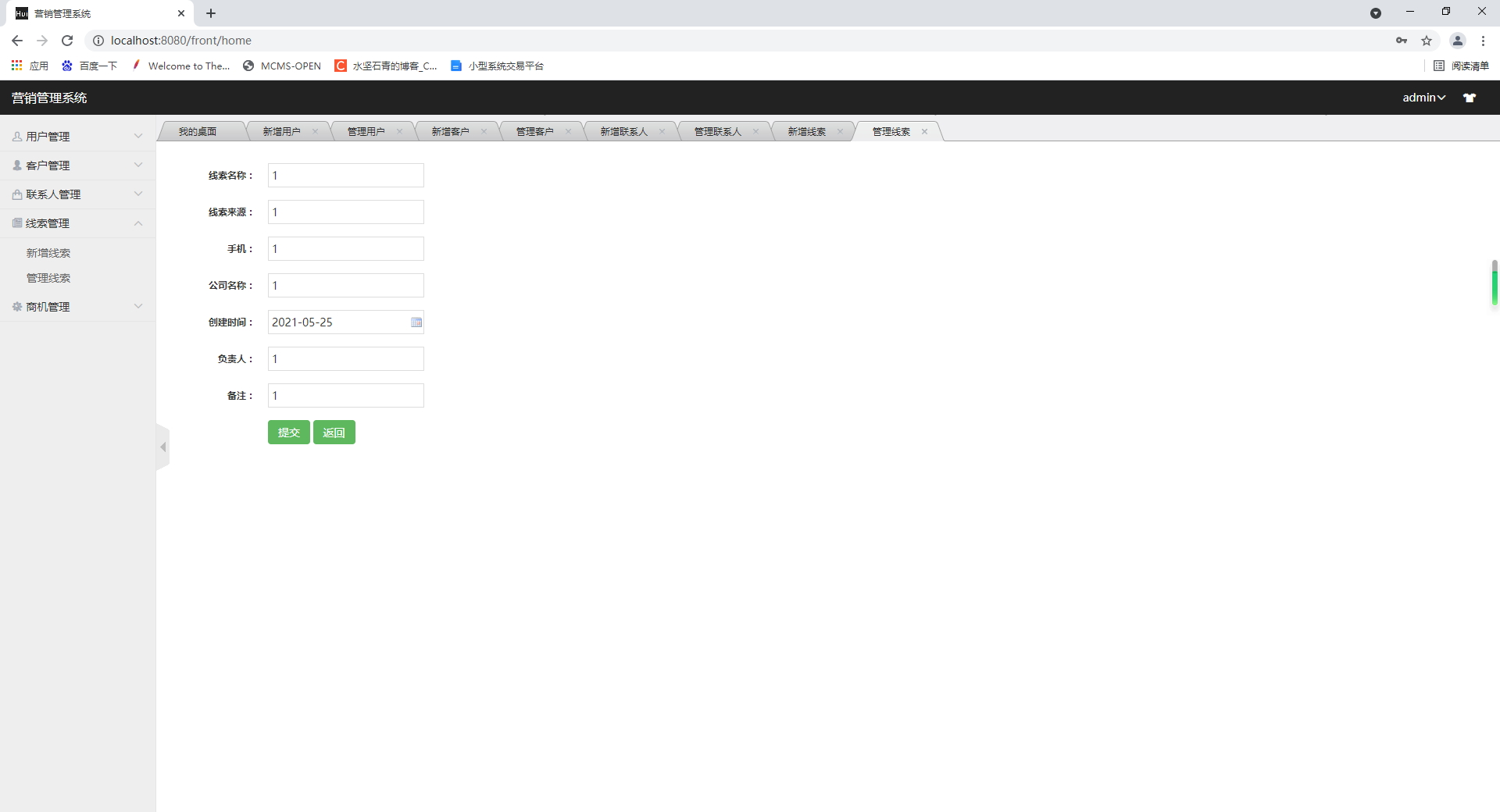
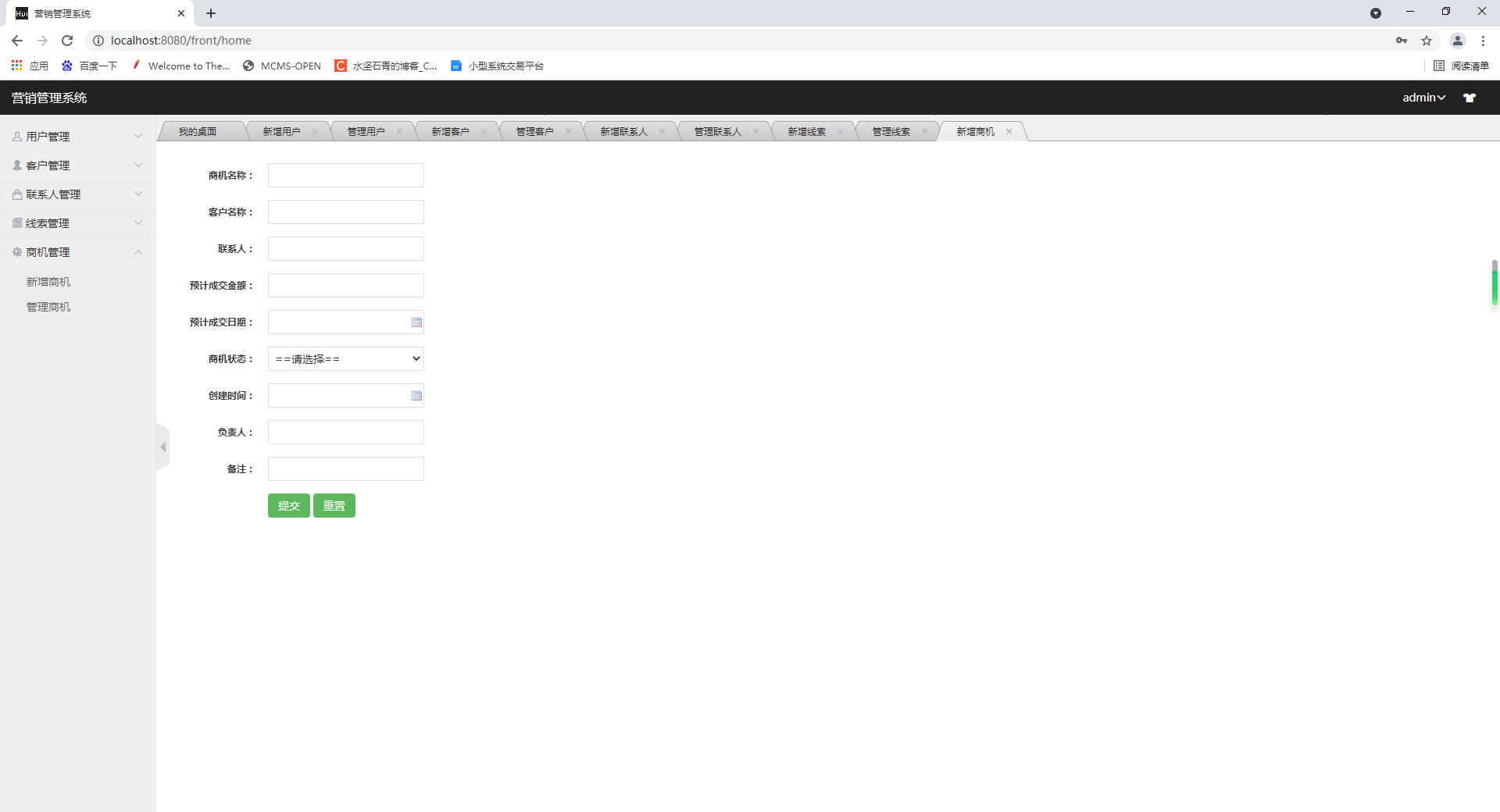
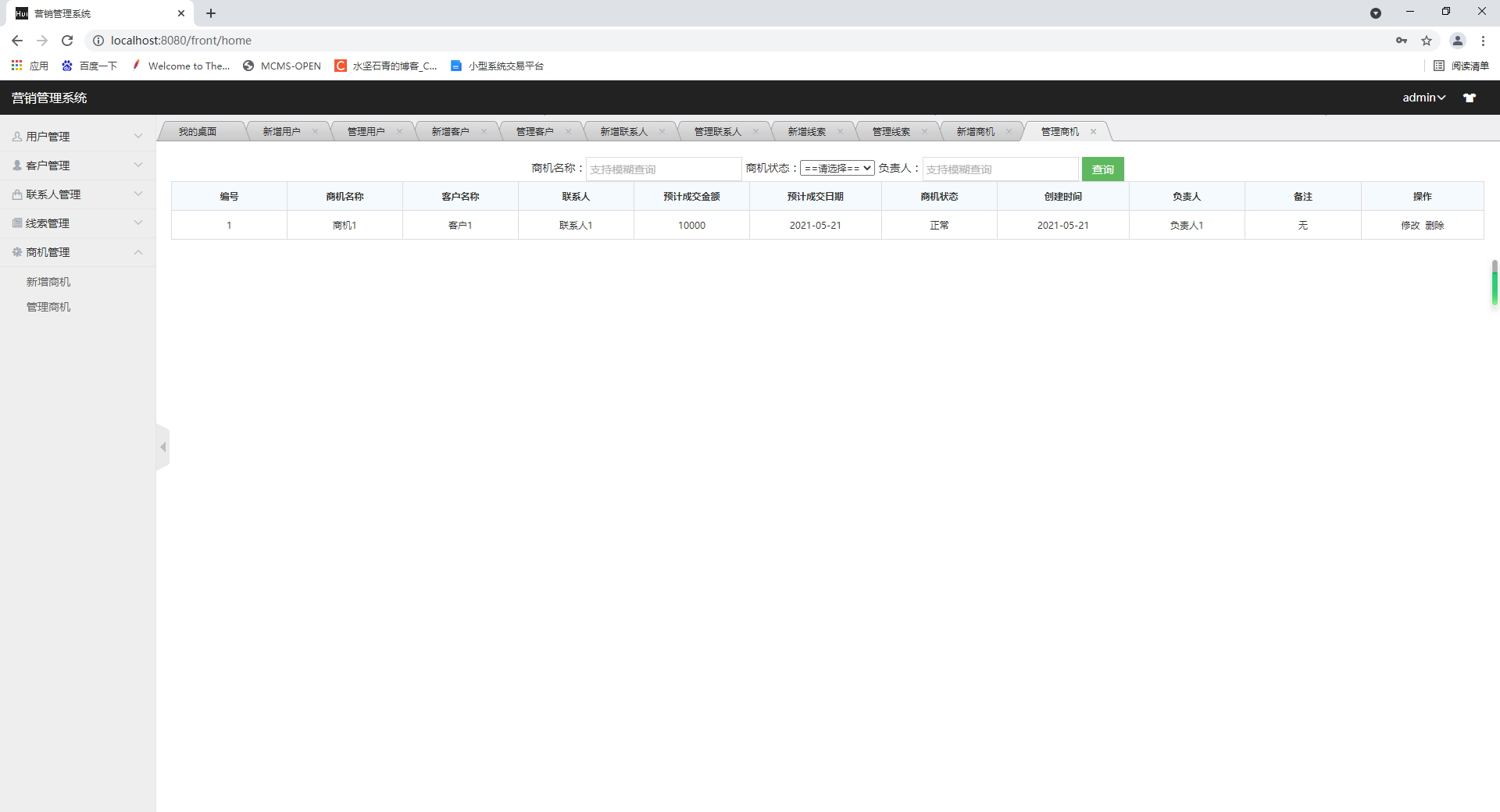
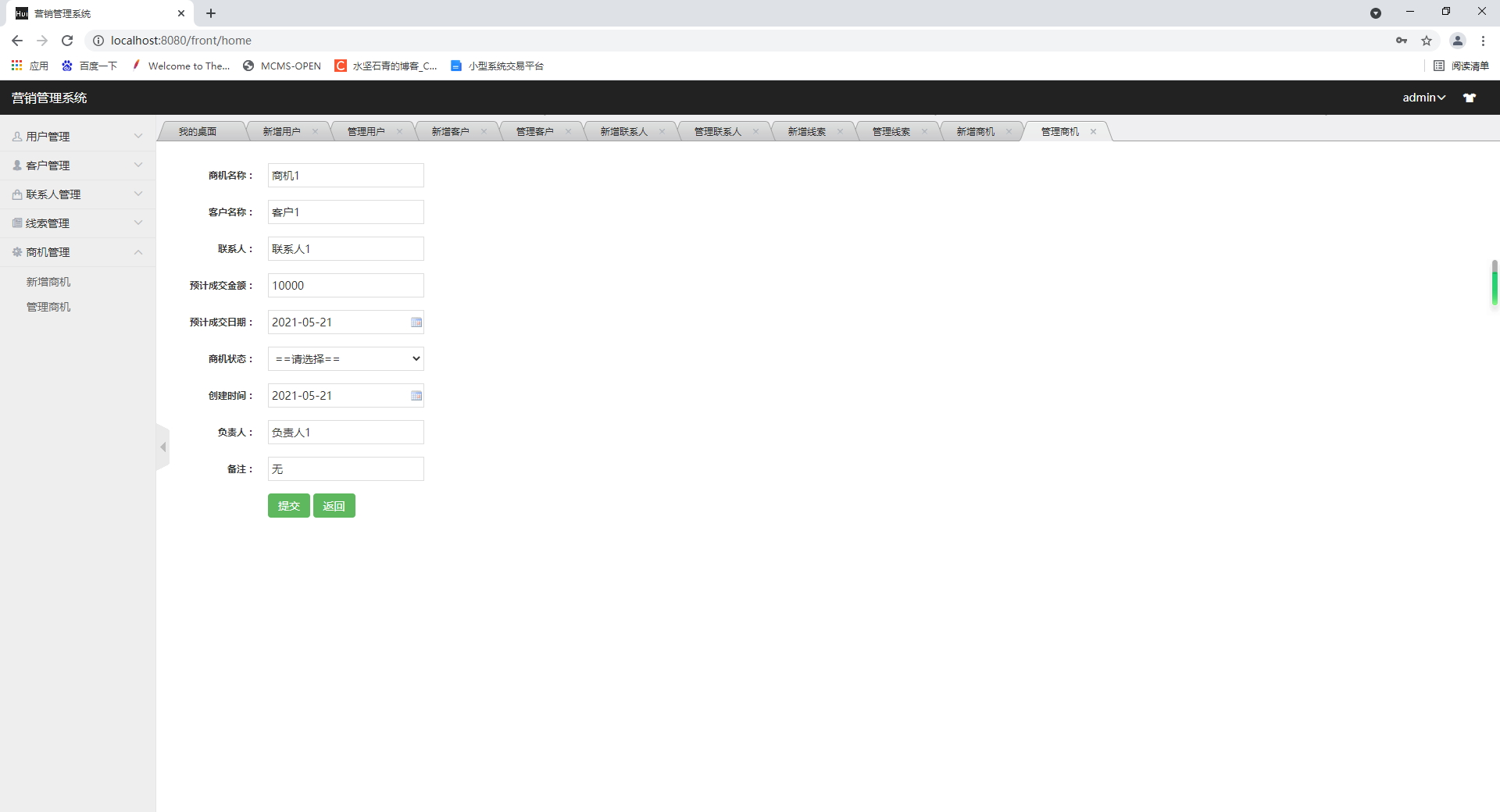
=====================================================================
package com.example.cra.controller;
import com.example.cra.entity.Business;
import com.example.cra.entity.Contact;
import com.example.cra.service.BusinessService;
import com.example.cra.service.ContactService;
import org.springframework.beans.factory.annotation.Autowired;
import org.springframework.web.bind.annotation.*;
import java.util.HashMap;
import java.util.List;
import java.util.Map;
@RestController
@RequestMapping(“/business”)
public class BusinessController {
@Autowired
private BusinessService businessService;
@RequestMapping(value = “/addbusiness” , method = RequestMethod.POST)
public Map<String,Object> addBusiness(@RequestBody Business business) {
Map<String, Object> map = new HashMap<String, Object>();
String result = businessService.addBusiness(business);
map.put(“msg”, result);
return map;
}
@RequestMapping(value = “/businessList” , method = RequestMethod.GET)
public Map<String,Object> businessList() {
Map<String, Object> map = new HashMap<String, Object>();
List business = businessService.businessList();
map.put(“business”,business);
return map;
}
@RequestMapping(value = “/delbusiness” , method = RequestMethod.GET)
public Map<String,Object> delBusinesss(@RequestParam(“business_id”) String business_id) {
Map<String, Object> map = new HashMap<String, Object>();
String result = businessService.delBusiness(Integer.parseInt(business_id));
map.put(“msg”,result);
return map;
}
@RequestMapping(value = “/querybusiness” , method = RequestMethod.POST)
public Map<String,Object> queryBusinesss(@RequestParam(“business_name”) String business_name,
@RequestParam(“business_state”) String business_state,
@RequestParam(“person”) String person) {
Map<String, Object> map = new HashMap<String, Object>();
List business = businessService.queryBusiness(business_name,business_state,person);
map.put(“business”,business);
return map;
}
@RequestMapping(value = “/selectbusiness” , method = RequestMethod.POST)
public Map<String,Object> selectBusiness(@RequestParam(“business_id”) String business_id) {
Map<String, Object> map = new HashMap<String, Object>();
Business business = businessService.selectBusiness(Integer.parseInt(business_id));
map.put(“business”,business);
return map;
}
@RequestMapping(value = “/updatebusiness” , method = RequestMethod.POST)
public Map<String,Object> updateBusiness(@RequestBody Business business) {
Map<String, Object> map = new HashMap<String, Object>();
boolean result = businessService.updateBusiness(business);
map.put(“success”,result);
return map;
}
}
package com.example.cra.controller;
import com.example.cra.entity.Clue;
import com.example.cra.service.ClueService;
import org.springframework.beans.factory.annotation.Autowired;
import org.springframework.web.bind.annotation.*;
import java.util.HashMap;
import java.util.List;
import java.util.Map;
@RestController
@RequestMapping(“/clue”)
public class ClueController {
@Autowired
private ClueService clueService;
@RequestMapping(value = “/addclue” , method = RequestMethod.POST)
public Map<String,Object> addClue(@RequestBody Clue clue) {
Map<String, Object> map = new HashMap<String, Object>();
String result = clueService.addClue(clue);
map.put(“msg”, result);
return map;
}
@RequestMapping(value = “/clueList” , method = RequestMethod.GET)
public Map<String,Object> clueList() {
Map<String, Object> map = new HashMap<String, Object>();
List clue = clueService.clueList();
map.put(“clue”,clue);
return map;
}
@RequestMapping(value = “/delclue” , method = RequestMethod.GET)
public Map<String,Object> delClues(@RequestParam(“clue_id”) String clue_id) {
Map<String, Object> map = new HashMap<String, Object>();
String result = clueService.delClue(Integer.parseInt(clue_id));
map.put(“msg”,result);
return map;
}
@RequestMapping(value = “/queryclue” , method = RequestMethod.POST)
public Map<String,Object> queryClues(@RequestParam(“clue_name”) String clue_name,
@RequestParam(“person”) String person) {
Map<String, Object> map = new HashMap<String, Object>();
List clue = clueService.queryClue(clue_name,person);
map.put(“clue”,clue);
return map;
}
@RequestMapping(value = “/selectclue” , method = RequestMethod.POST)
public Map<String,Object> selectClue(@RequestParam(“clue_id”) String clue_id) {
Map<String, Object> map = new HashMap<String, Object>();
Clue clue = clueService.selectClue(Integer.parseInt(clue_id));
map.put(“clue”,clue);
return map;
}
@RequestMapping(value = “/updateclue” , method = RequestMethod.POST)
public Map<String,Object> updateClue(@RequestBody Clue clue) {
Map<String, Object> map = new HashMap<String, Object>();
boolean result = clueService.updateClue(clue);
map.put(“success”,result);
return map;
}
}
package com.example.cra.controller;
import com.example.cra.entity.Contact;
import com.example.cra.service.ContactService;
import org.springframework.beans.factory.annotation.Autowired;
import org.springframework.web.bind.annotation.*;
import java.util.HashMap;
import java.util.List;
import java.util.Map;
@RestController
@RequestMapping(“/contacts”)
public class ContactController {
@Autowired
private ContactService contactService;
@RequestMapping(value = “/addcontacts” , method = RequestMethod.POST)
public Map<String,Object> addContact(@RequestBody Contact contact) {
Map<String, Object> map = new HashMap<String, Object>();
String result = contactService.addContact(contact);
map.put(“msg”, result);
return map;
}
@RequestMapping(value = “/contactsList” , method = RequestMethod.GET)
public Map<String,Object> contactList() {
Map<String, Object> map = new HashMap<String, Object>();
List contact = contactService.contactList();
map.put(“contact”,contact);
return map;
}
@RequestMapping(value = “/delcontacts” , method = RequestMethod.GET)
public Map<String,Object> delContacts(@RequestParam(“cont_id”) String contacts_id) {
Map<String, Object> map = new HashMap<String, Object>();
String result = contactService.delContact(Integer.parseInt(contacts_id));
map.put(“msg”,result);
return map;
}
@RequestMapping(value = “/querycontacts” , method = RequestMethod.POST)
public Map<String,Object> queryContacts(@RequestParam(“customer_name”) String customer_name,
@RequestParam(“telephone”) String telephone,
@RequestParam(“contacts_name”) String contacts_name) {
Map<String, Object> map = new HashMap<String, Object>();
List contact = contactService.queryContact(customer_name,telephone,contacts_name);
map.put(“contact”,contact);
return map;
}
@RequestMapping(value = “/selectcontacts” , method = RequestMethod.POST)
public Map<String,Object> selectContact(@RequestParam(“cont_id”) String contacts_id) {
Map<String, Object> map = new HashMap<String, Object>();
Contact contact = contactService.selectContact(Integer.parseInt(contacts_id));
map.put(“contact”,contact);
return map;
}
@RequestMapping(value = “/updatecontacts” , method = RequestMethod.POST)
public Map<String,Object> updateContact(@RequestBody Contact contact) {
Map<String, Object> map = new HashMap<String, Object>();
boolean result = contactService.updateContact(contact);
map.put(“success”,result);
return map;
}
}
package com.example.cra.controller;
import com.example.cra.entity.Customer;
import com.example.cra.service.CustomerService;
import org.springframework.beans.factory.annotation.Autowired;
import org.springframework.web.bind.annotation.*;
import java.util.HashMap;
import java.util.List;
import java.util.Map;
@RestController
@RequestMapping(“/customers”)
public class CustomerController {
@Autowired
private CustomerService customerService;
@RequestMapping(value = “/listCustomers” , method = RequestMethod.GET)
public Map<String,Object> listCustomers() {
Map<String, Object> map = new HashMap<String, Object>();
List customers = customerService.getAllCustomers();
map.put(“customers”, customers);
return map;
}
@RequestMapping(value = “/querycustomers” , method = RequestMethod.POST)
public Map<String,Object> queryCustomer(@RequestParam(“customer_name”) String customer_name,
@RequestParam(“person”) String person,
@RequestParam(“customer_state”) String customer_state) {
Map<String, Object> map = new HashMap<String, Object>();
List customer = customerService.queryCustomer(customer_name,person,customer_state);
map.put(“customer”, customer);
return map;
}
@RequestMapping(value = “/addcustomer” , method = RequestMethod.POST)
public Map<String,Object> addCustomer(@RequestBody Customer customer) {
Map<String, Object> map = new HashMap<String, Object>();
String result = customerService.insertCustomer(customer);
map.put(“msg”, result);
return map;
}
@RequestMapping(value = “/updatecustomer” , method = RequestMethod.POST)
public Map<String,Object> updateCustomer(@RequestBody Customer customer) {
Map<String, Object> map = new HashMap<String, Object>();
String result = customerService.updateCustomer(customer);
map.put(“msg”, result);
return map;
}
@RequestMapping(value = “/deletecustomer” , method = RequestMethod.POST)
public Map<String,Object> deleteCustomer(@RequestParam(“customer_id”) Integer customer_id) {
Map<String, Object> map = new HashMap<String, Object>();
String result = customerService.deleteCustomer(customer_id);
map.put(“msg”, result);
return map;
}
@RequestMapping(value = “/getcustomer” , method = RequestMethod.POST)
public Map<String,Object> getCustomer(@RequestParam(“customer_id”) Integer customer_id) {
Map<String, Object> map = new HashMap<String, Object>();
Customer customer = customerService.getCustomer(customer_id);
map.put(“customer”, customer);
return map;
}
}
package com.example.cra.controller;
import org.springframework.stereotype.Controller;
import org.springframework.web.bind.annotation.RequestMapping;
import org.springframework.web.bind.annotation.RequestMethod;
@Controller
@RequestMapping(“/front”)
public class FrontendController {
@RequestMapping(value = “/index”, method = RequestMethod.GET)
public String login() {
return “index”;
}
@RequestMapping(value = “/home”, method = RequestMethod.GET)
public String index() {
return “home”;
}
@RequestMapping(value = “/user-add”, method = RequestMethod.GET)
public String userAdd() {
return “user-add”;
}
@RequestMapping(value = “/user-list”, method = RequestMethod.GET)
public String userList() {
return “user-list”;
}
@RequestMapping(value = “/user-update”, method = RequestMethod.GET)
public String userUpdate() {
return “user-update”;
}
@RequestMapping(value = “/contact-add”, method = RequestMethod.GET)
public String contactAdd() {
return “contact-add”;
}
@RequestMapping(value = “/contact-list”, method = RequestMethod.GET)
public String contactList() {
return “contact-list”;
}
@RequestMapping(value = “/contact-update”, method = RequestMethod.GET)
public String contactUpdate() {
return “contact-update”;
}
@RequestMapping(value = “/customer-add”, method = RequestMethod.GET)
public String customerAdd() {
return “customer-add”;
}
@RequestMapping(value = “/customer-list”, method = RequestMethod.GET)
public String customerList() {
return “customer-list”;
}
@RequestMapping(value = “/customer-update”, method = RequestMethod.GET)
public String customerUpdate() {
return “customer-update”;
}
@RequestMapping(value = “/clue-add”, method = RequestMethod.GET)
public String bookinfoAdd() {
return “clue-add”;
}
@RequestMapping(value = “/clue-list”, method = RequestMethod.GET)
public String bookinfoList() {
return “clue-list”;
}
@RequestMapping(value = “/clue-update”, method = RequestMethod.GET)
public String bookinfoUpdate() {
return “clue-update”;
}
@RequestMapping(value = “/business-add”, method = RequestMethod.GET)
public String logAdd() {
return “business-add”;
}
@RequestMapping(value = “/business-list”, method = RequestMethod.GET)
public String logList() {
return “business-list”;
}
@RequestMapping(value = “/business-update”, method = RequestMethod.GET)
public String logUpdate() {
return “business-update”;
}
}
package com.example.cra.controller;
import com.example.cra.entity.User;
import com.example.cra.service.UserService;
import com.example.cra.util.SelectUsers;
import org.springframework.beans.factory.annotation.Autowired;
import org.springframework.web.bind.annotation.*;
import javax.servlet.http.HttpServletRequest;
import java.text.ParseException;
import java.util.*;
@RestController
@RequestMapping(“/users”)
public class UserController {
@Autowired
private UserService usersService;
//登录
@RequestMapping(value = “/login”, method = RequestMethod.POST)
public Map<String, Object> login(@RequestParam(“username”) String username,
@RequestParam(“password”) String password, HttpServletRequest request) {
Map<String, Object> map = new HashMap<String, Object>();
User result = usersService.login(username, password);
if (result != null) {
request.getSession().setAttribute(“username”, username);
map.put(“success”, true);
map.put(“msg”, “登陆成功!”);
} else {
map.put(“success”, false);
map.put(“msg”, “登陆失败!”);
}
return map;
}
//系统管理员创建用户信息,默认角色为销售
@RequestMapping(value = “/addUsers”, method = RequestMethod.POST)
public Map<String, Object> addUsers(@RequestBody User user) throws ParseException {
Map<String, Object> map = new HashMap<String, Object>();
String result = usersService.createUsers(user);
map.put(“msg”, result);
return map;
}
@RequestMapping(value = “/selectUsers”, method = RequestMethod.POST)
public Map<String, Object> selectUsers(@RequestParam(“select_username”) String username,
@RequestParam(“select_sex”) String sex,
@RequestParam(“select_role”) String role,
@RequestParam(“select_status”) String select_status) throws ParseException {
Map<String, Object> map = new HashMap<String, Object>();
SelectUsers selectUsers = new SelectUsers();
selectUsers.setUsername(username);
selectUsers.setSex(sex);
selectUsers.setSelect_role(role);
selectUsers.setSelect_status(select_status);
List users = usersService.selectUsers(selectUsers);
map.put(“users”, users);
return map;
}
//修改用户角色
@RequestMapping(value = “/editUsers”, method = RequestMethod.POST)
public Map<String, Object> editUsers(@RequestBody User user) {
Map<String, Object> map = new HashMap<String, Object>();
String result = usersService.updateUser(user);
map.put(“msg”, result);
return map;
}
//系统管理员对系统所有用户进行删除
@RequestMapping(value = “/delUsers”, method = RequestMethod.GET)
public Map<String, Object> delUsers(@RequestParam(“user_id”) String user_id) {
Map<String, Object> map = new HashMap<String, Object>();
String result = usersService.delUsers(user_id);
map.put(“msg”, result);
return map;
}
//系统管理员对系统所有用户进行查看
@RequestMapping(value = “/listUsers”, method = RequestMethod.GET)
public Map<String, Object> listUsers() {
Map<String, Object> map = new HashMap<String, Object>();
List users = new ArrayList();
users = usersService.listUsers();
map.put(“users”, users);
return map;
}
//获取session
@RequestMapping(value = “/session”, method = RequestMethod.POST)
public Map<String, Object> session(HttpServletRequest request) {
Map<String, Object> map = new HashMap<String, Object>();
map.put(“session”, request.getSession().getAttribute(“username”));
return map;
}
//通过用户名获取用户id
@RequestMapping(value = “/getUserId”, method = RequestMethod.GET)
public Map<String, Integer> getUserId(@RequestParam(“username”) String username) {
Map<String, Integer> map = new HashMap<String, Integer>();
Integer user_id = usersService.findUserIdByUserName(username);
map.put(“user_id”, user_id);
System.out.println(user_id);
return map;
}
//检测用户名
@RequestMapping(value = “/checkname”, method = RequestMethod.POST)
public Map<String, Object> checkname(@RequestParam(“username”) String username) {
Map<String, Object> map = new HashMap<String, Object>();
String result = usersService.checkname(username);
map.put(“msg”, result);
return map;
}
@RequestMapping(value = “/selectuser”, method = RequestMethod.POST)
public Map<String, Object> selectuser(@RequestParam(“userid”) String user_id) {
Map<String, Object> map = new HashMap<String, Object>();
User result = usersService.queryuser(Integer.parseInt(user_id));
map.put(“users”, result);
return map;
}
@RequestMapping(value = “/updateuser”, method = RequestMethod.POST)
public Map<String, Object> updateUser(@RequestBody User user) throws ParseException {
Map<String, Object> map = new HashMap<String, Object>();
String result = usersService.updateUser(user);
map.put(“success”,result);
return map;
}
}
$(function () {
//刷新页面
$(‘#reload_btn’).click(function(){
$(‘#business_name’).val(‘’);
$(“#customer_name”).val(‘’);
$(‘#contacts’).val(‘’);
$(‘#amount’).val(‘’);
$(‘#date’).val(‘’);
$(‘#business_state’).val(‘’);
$(‘#create_time’).val(‘’);
$(‘#person’).val(‘’);
$(‘#remark’).val(‘’);
window.location.reload();
});
// 新增用户
$(‘#submit_btn’).click(function () {
var business_name = $(‘#business_name’).val();
var customer_name = $(“#customer_name”).val();
var contacts = $(‘#contacts’).val();
var amount = $(‘#amount’).val();
var date = $(‘#date’).val();
var business_state = $(‘#business_state’).val();
var create_time = $(‘#create_time’).val();
var person = $(‘#person’).val();
var remark = $(‘#remark’).val();
var param = {
“business_name”: business_name,
“customer_name”: customer_name,
“contacts”:contacts,
“amount”:amount,
“date”:date,
“business_state”:business_state,
“create_time”:create_time,
“person”: person,
“remark”: remark
};
$.ajax({
url: “/business/addbusiness”,
async: false,
cache: false,
知其然不知其所以然,大厂常问面试技术如何复习?
1、热门面试题及答案大全
面试前做足功夫,让你面试成功率提升一截,这里一份热门350道一线互联网常问面试题及答案助你拿offer

2、多线程、高并发、缓存入门到实战项目pdf书籍



3、文中提到面试题答案整理

4、Java核心知识面试宝典
覆盖了JVM 、JAVA集合、JAVA多线程并发、JAVA基础、Spring原理、微服务、Netty与RPC、网络、日志、Zookeeper、Kafka、RabbitMQ、Hbase、MongoDB 、Cassandra、设计模式、负载均衡、数据库、一致性算法 、JAVA算法、数据结构、算法、分布式缓存、Hadoop、Spark、Storm的大量技术点且讲解的非常深入



me = $(‘#business_name’).val();
var customer_name = $(“#customer_name”).val();
var contacts = $(‘#contacts’).val();
var amount = $(‘#amount’).val();
var date = $(‘#date’).val();
var business_state = $(‘#business_state’).val();
var create_time = $(‘#create_time’).val();
var person = $(‘#person’).val();
var remark = $(‘#remark’).val();
var param = {
“business_name”: business_name,
“customer_name”: customer_name,
“contacts”:contacts,
“amount”:amount,
“date”:date,
“business_state”:business_state,
“create_time”:create_time,
“person”: person,
“remark”: remark
};
$.ajax({
url: “/business/addbusiness”,
async: false,
cache: false,
知其然不知其所以然,大厂常问面试技术如何复习?
1、热门面试题及答案大全
面试前做足功夫,让你面试成功率提升一截,这里一份热门350道一线互联网常问面试题及答案助你拿offer
[外链图片转存中…(img-ScjPwD71-1714854441133)]
2、多线程、高并发、缓存入门到实战项目pdf书籍
[外链图片转存中…(img-HssVt2wQ-1714854441133)]
[外链图片转存中…(img-DBlzDOo2-1714854441134)]
[外链图片转存中…(img-NXRiGmI1-1714854441134)]
3、文中提到面试题答案整理
[外链图片转存中…(img-maNebcJC-1714854441134)]
4、Java核心知识面试宝典
覆盖了JVM 、JAVA集合、JAVA多线程并发、JAVA基础、Spring原理、微服务、Netty与RPC、网络、日志、Zookeeper、Kafka、RabbitMQ、Hbase、MongoDB 、Cassandra、设计模式、负载均衡、数据库、一致性算法 、JAVA算法、数据结构、算法、分布式缓存、Hadoop、Spark、Storm的大量技术点且讲解的非常深入
[外链图片转存中…(img-VNOIp0C1-1714854441135)]
[外链图片转存中…(img-Ae2PV7Hh-1714854441135)]
[外链图片转存中…(img-bbtPwbVy-1714854441135)]






















 589
589











 被折叠的 条评论
为什么被折叠?
被折叠的 条评论
为什么被折叠?








